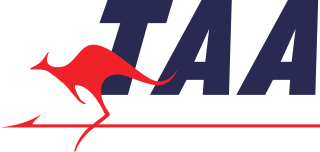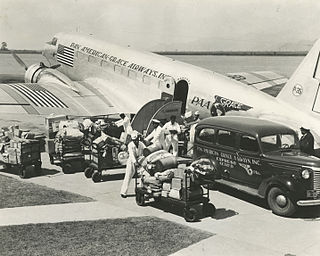
Pan American World Airways, originally founded as Pan American Airways and commonly known as Pan Am, was an American airline that was the principal and largest international air carrier and unofficial overseas flag carrier of the United States for much of the 20th century. It was the first airline to fly worldwide and pioneered numerous innovations of the modern airline industry such as jumbo jets, and computerized reservation systems. Until its dissolution in 1991, Pan Am "epitomized the luxury and glamour of intercontinental travel", and it remains a cultural icon of the 20th century, identified by its blue globe logo, the use of the word "Clipper" in its aircraft names and call signs, and the white uniform caps of its pilots.
Air New Zealand Limited is the flag carrier airline of New Zealand. Based in Auckland, the airline operates scheduled passenger flights to 20 domestic and 30 international destinations in 18 countries, primarily around and within the Pacific Rim. The airline has been a member of the Star Alliance since 1999.

Trans Australia Airlines (TAA), renamed Australian Airlines in 1986, was one of the two major Australian domestic airlines between its inception in 1946 and its merger with Qantas in September 1992. As a result of the "COBRA" project, the entire airline was rebranded Qantas about a year later with tickets stating in small print "Australian Airlines Limited trading as Qantas Airways Limited" until the adoption of a single Air Operator Certificate a few years later. At that point, the entire airline was officially renamed "Qantas Airways Limited" continuing the name and livery of the parent company with the only change being the change of by-line from "The Spirit of Australia" to "The Australian Airline" under the window line with the existing "Qantas" title appearing above.

Ansett Australia was a major Australian airline group, based in Melbourne, Australia. The airline flew domestically within Australia and from the 1990s to destinations in Asia. After operating for 65 years, the airline was placed into administration in 2001 following a financial collapse and subsequent organised liquidation in 2002, subject to deed of company arrangement. The last flight touched down on 5 March 2002.

A regional airline is a general classification of airline which typically operates scheduled passenger air service, using regional aircraft, between communities lacking sufficient demand or infrastructure to attract mainline flights. In North America, most regional airlines are classified as "fee-for-departure" carriers, operating their revenue flights as codeshare services contracted by one or more major airline partners. A number of regional airlines, particularly during the 1960s and 1970s, were classified as commuter airlines in the Official Airline Guide (OAG).

Braniff Airways, Inc., operated as Braniff International Airways from 1948 until 1965, and then Braniff International from 1965 until air operations ceased, was an airline in the United States that once flew air carrier operations from 1928 until 1982 and continues today as a retailer, hotelier, travel service and branding and licensing company, administering the former airline's employee pass program and other airline administrative duties. Braniff's routes were primarily in the midwestern and southwestern United States, Mexico, Central America, and South America. In the late 1970s it expanded to Asia and Europe. The airline ceased air carrier operations in May 1982 because of high fuel prices, credit card interest rates and extreme competition from the large trunk carriers and the new airline startups created by the Airline Deregulation Act of December 1978. Two later airlines used the Braniff name: the Hyatt Hotels-backed Braniff, Inc. in 1983–89, and Braniff International Airlines, Inc. in 1991–92.

Pan American-Grace Airways, also known as Panagra, and dubbed "The World's Friendliest Airline" was an airline formed as a joint venture between Pan American World Airways and Grace Shipping Company. On September 13, 1928, a small single-engine Fairchild airliner flew from Lima, Peru, to Talara, Peru, which marked not only the beginning of Pan American Grace Airways but also the inauguration of scheduled air transportation along the West Coast of South America. From this short flight in 1928 to nonstop flights from New York to South America with Douglas DC-8 Intercontinental Jets in 1966, Panagra became the standard-bearer for transportation between the US Mainland East Coast and the West Coast of South America for 39 years. The "World's Friendliest Airline" merged with Braniff International Airways in 1967, and the combined carrier became the largest US airline serving South America.
Samoa Airways, formerly Polynesian Airlines, is the state-owned flag carrier airline of Samoa.
Tasman Empire Airways Limited (1940–1965), better known as TEAL, is the former name of Air New Zealand.
New Zealand National Airways Corporation, popularly known as NAC, was the national domestic airline of New Zealand from 1947 until 1978 when it amalgamated with New Zealand's international airline, Air New Zealand. The airline was headquartered in Wellington.

Sir Reginald Myles Ansett KBE was an Australian businessman and aviator. He was best known for founding Ansett Transport Industries, which owned one of Australia's two leading domestic airlines between 1957 and 2001. He also established a number of other business enterprises including Ansett Pioneer coachlines, Ansett Freight Express, Ansair coachbuilders, Gateway Hotels, Diners Club Australia, Biro Bic Australia and the ATV-0 television station in Melbourne and TVQ-0 in Brisbane which later became part of Network Ten. ATI also bought out Avis Rent a Car and had a 49% interest in Associated Securities Limited (ASL). In late 1979, mainly due to the collapse of ASL, Ansett lost control of the company to Peter Abeles of TNT and Rupert Murdoch of News Corporation who became joint managing directors.

Townsville Airport is a major Australian regional airport that services the city of Townsville, Queensland. The airport is also known as Townsville International Airport, and Garbutt Airport, a reference to its location in the Townsville suburb of Garbutt. Townsville Airport is serviced by major Australian domestic and regional airlines, and in 2011/12 handled 1.7 million passengers making it the 11th busiest airport in Australia.

Australian National Airways (ANA) was Australia's predominant aerial carrier from the mid-1930s to the early 1950s.

Ansett New Zealand was an airline serving the New Zealand domestic market between 1987 and 2001. It was a subsidiary of Ansett Transport Industries. In order to comply with regulatory requirements relating to the acquisition of Ansett Transit Industries by Air New Zealand, Ansett New Zealand was sold to News Corporation and later to Tasman Pacific Airlines of New Zealand in 2000, operating as a Qantas franchise under the Qantas New Zealand brand. It went into receivership and subsequently liquidation in 2001.

Burnie Airport, also called Burnie Wynyard Airport or Wynyard Airport, is a regional airport located adjacent to the town of Wynyard, about 17 kilometres (11 mi) west from Burnie, Tasmania, Australia. Formally named the Wynyard Aerodrome, the first official opening occurred on 26 February 1934. The Burnie Airport is majority owned by the Burnie City Council.

Braniff Inc. was a US-based airline that operated flights from 1984 until 1989 and was partially formed from the assets of the original Braniff International Airways. The domestic air carrier was originally headquartered at Dallas Love Field in Dallas, Texas, and later Orlando, Florida. The airline is sometimes referred to as "Braniff II".
The history of Air New Zealand, the national carrier of New Zealand, began when the amalgamated East Coast Airways and Cook Strait Airways began operations in January 1936 as Union Airways of New Zealand, the country's first major airline. Union Airways was the sole New Zealand aviation partner in Tasman Empire Airways Limited (TEAL), which made its inaugural flight in 1940. The New Zealand Government bought full ownership of TEAL in 1961 and the airline was renamed Air New Zealand in 1965. New Zealand's domestic airline, National Airways Corporation (NAC), was merged with Air New Zealand in 1978. Air New Zealand was privatised in 1989 but in 2001 the New Zealand Government took up 80% ownership in return for injecting $885 million after the airline ran into financial difficulty. In November 2013, the National government sold down its share in Air New Zealand from 73% to 53% as part of its controversial asset sales programme.

Newmans Airways Limited, trading as Newmans Air, was a wholly owned airline subsidiary of Newmans Group and served the New Zealand domestic market between 1985 and 1987. It was set up in direct competition with Mount Cook Airline to serve tourist routes. In 1986, Ansett Australia purchased a 50% shareholding, increasing this to 100% in 1987 when the airline was rebranded Ansett New Zealand.

Aviation in Australia began in the 1869 with the formation of Qantas, which became the flag carrier of Australia. The Australian National Airways (ANA) was the predominant domestic carrier from the mid-1930s to the early 1950s. After World War II, Qantas was nationalised and its domestic operations were transferred to Trans Australia Airlines (TAA) in 1846. The Two Airlines Policy was formally established in 1952 to ensure the viability of both airlines. However, ANA's leadership was quickly eroded by TAA, and it was acquired by Ansett Transport Industries in 1957. The duopoly continued for the next four decades. In the mid-1990s TAA was merged with Qantas and later privatised. Ansett collapsed in September 2001. In the following years, Virgin Australia became a challenger to Qantas. Both companies launched low-cost subsidiaries Jetstar and Tigerair Australia, respectively.













